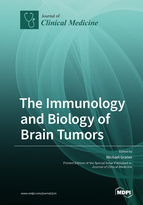The Immunology and Biology of Brain Tumors
A special issue of Journal of Clinical Medicine (ISSN 2077-0383). This special issue belongs to the section "Oncology".
Deadline for manuscript submissions: closed (30 September 2019) | Viewed by 20771
Special Issue Editor
Special Issue Information
Dear Colleagues,
We welcome your contributions to this Special Issue entitled “The Immunology and Biology of Brain Tumors”. Immunotherapy has become a viable treatment modality for a variety of cancers (and referred to as Science Magazine’s “Breakthrough of the Year” in 2013, as well as ASCO’s “Advance of the Year” in both 2016 and 2017). This Special Issue will focus on the relevance of immunobiology in brain tumors, touching on elements of immune suppression, immune stimulation, the immune microenvironment, with culminations in translational immunotherapy. Topics include, but are not limited to:
History of Brain Tumor Immunotherapy
Immune Checkpoints
Immune Checkpoint Inhibitors
Immune Suppression
- by the tumor microenvironment
- by tumor-release factors
- in peripheral compartments
- regulatory T cells
- MDSCs
Immune Stimulation
Inflammation
Vaccines
- DC-based
- proteins
- nucleic acids
- cellular
- nanomaterials
Immune Transfer
- adoptive T cells
- CAR-T cells
- serologic
- antibodies and constructs
Combination Therapies
Animal Models
Companion Animals
Journal of Clinical Medicine (ISSN 2077-0383; CODEN: JCMOHK) is an international, open access journal published monthly online by MDPI. It is indexed in the Science Citation Index Expanded (SCIE) in Web of Science and other databases. Citations become available in PubMed, with full-text archived in PubMed Central.
Prof. Michael Graner
Guest Editor
Manuscript Submission Information
Manuscripts should be submitted online at www.mdpi.com by registering and logging in to this website. Once you are registered, click here to go to the submission form. Manuscripts can be submitted until the deadline. All submissions that pass pre-check are peer-reviewed. Accepted papers will be published continuously in the journal (as soon as accepted) and will be listed together on the special issue website. Research articles, review articles as well as short communications are invited. For planned papers, a title and short abstract (about 100 words) can be sent to the Editorial Office for announcement on this website.
Submitted manuscripts should not have been published previously, nor be under consideration for publication elsewhere (except conference proceedings papers). All manuscripts are thoroughly refereed through a single-blind peer-review process. A guide for authors and other relevant information for submission of manuscripts is available on the Instructions for Authors page. Journal of Clinical Medicine is an international peer-reviewed open access semimonthly journal published by MDPI.
Please visit the Instructions for Authors page before submitting a manuscript. The Article Processing Charge (APC) for publication in this open access journal is 2600 CHF (Swiss Francs). Submitted papers should be well formatted and use good English. Authors may use MDPI's English editing service prior to publication or during author revisions.
Keywords
- History of Brain Tumor Immunotherapy
- Immune Checkpoints
- Immune Checkpoint Inhibitors
- Immune Suppression
- Immune Stimulation
- Inflammation
- Vaccines
- Immune Transfer
- Combination Therapies
- Animal Models
- Companion Animals







